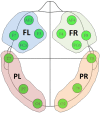Neurophysiological Synchrony Between Children With Severe Physical Disabilities and Their Parents During Music Therapy
- PMID: 33994913
- PMCID: PMC8119766
- DOI: 10.3389/fnins.2021.531915
Neurophysiological Synchrony Between Children With Severe Physical Disabilities and Their Parents During Music Therapy
Abstract
Although physiological synchronization has been associated with the level of empathy in emotionally meaningful relationships, little is known about the interbrain synchrony between non-speaking children with severe disabilities and their familial caregivers. In a repeated measures observational study, we ascertained the degree of interbrain synchrony during music therapy in 10 child-parent dyads, where the children were non-speaking and living with severe motor impairments. Interbrain synchrony was quantified via measurements of spectral coherence and Granger causality between child and parent electroencephalographic (EEG) signals collected during ten 15-min music therapy sessions per dyad, where parents were present as non-participating, covert observers. Using cluster-based permutation tests, we found significant child-parent interbrain synchrony, manifesting most prominently across dyads in frontal brain regions within β and low γ frequencies. Specifically, significant dyadic coherence was observed contra-laterally, between child frontal right and parental frontal left regions at β and lower γ bands in empathy-related brain areas. Furthermore, significant Granger influences were detected bidirectionally (from child to parent and vice versa) in the same frequency bands. In all dyads, significant increases in session-specific coherence and Granger influences were observed over the time course of a music therapy session. The observed interbrain synchrony suggests a cognitive-emotional coupling during music therapy between child and parent that is responsive to change. These findings encourage further study of the socio-empathic capacity and interpersonal relationships formed between caregivers and non-speaking children with severe physical impairments.
Keywords: EEG; child-parent dyad; children with severe physical disabilities; granger influence; interbrain synchrony; music therapy; neural synchrony; spectral coherence.
Copyright © 2021 Samadani, Kim, Moon, Kang and Chau.
Conflict of interest statement
The authors declare that the research was conducted in the absence of any commercial or financial relationships that could be construed as a potential conflict of interest.
Figures








References
-
- Altshuler I. (1948). The Past, Present, and Future of Musical Therapy. PODOLSKY, Edward. Music Therapy. New York, NY: Philosophical Library.
LinkOut - more resources
Full Text Sources
Other Literature Sources

